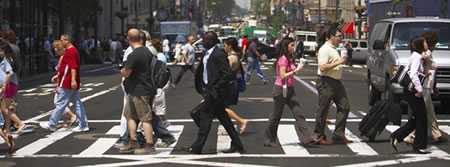Pedestrian Safety

In 2015, 5,376 pedestrians were killed in traffic crashes in the United States.1 This averages to one crash-related pedestrian death every 1.6 hours.1
Additionally, almost 129,000 pedestrians were treated in emergency departments for non-fatal crash-related injuries in 2015.2 Pedestrians are 1.5 times more likely than passenger vehicle occupants to be killed in a car crash on each trip.3
Who is most at risk?
Older adults
Pedestrians ages 65 and older accounted for 19% of all pedestrian deaths and an estimated 13% of all pedestrians injured in 2015.1
Children
In 2015, one in every five children under the age of 15 who were killed in traffic crashes were pedestrians.1
Drivers and pedestrians who are alcohol-impaired
Almost half (48%) of crashes that resulted in pedestrian deaths involved alcohol for the driver or the pedestrian. One in every three (34%) of fatal pedestrian crashes involved a pedestrian with a blood alcohol concentration (BAC) of at least 0.08 grams per deciliter (g/dL) and 15% involved a driver with a BAC of at least 0.08 g/dL.1
Additional Risk Factors
Additionally, higher vehicle speeds increase both the likelihood of a pedestrian being struck by a car and the severity of injury.4
Most pedestrian deaths occur in urban areas, non-intersection locations, and at night.1
How can pedestrians help prevent injuries and deaths from motor vehicle crashes?
Pedestrians can increase their visibility at night by carrying a flashlight when walking and by wearing retro-reflective clothing.1
Whenever possible, cross the street at a designated crosswalk or intersection.1
It is much safer to walk on a sidewalk or path, but if a sidewalk or path is not available, walk on the shoulder and facing traffic.1
Additional Resources
- National Highway Traffic Safety Administration (NHTSA): Pedestrian Safety
- NHTSA: Countermeasures That Work
- Federal Highway Administration/ Safe Routes to School Program
- National Center for Safe Routes to School
- National Safe Kids Campaign
- Pedestrian and Bicycle Information Center
- World Health Organization: Pedestrian safety: a road safety manual for decision-makers and practitioners
References
- National Highway Traffic Safety Administration. Traffic Safety Facts 2015 Data – Pedestrians. Washington, DC: US Department of Transportation, National Highway Traffic Safety Administration; 20175. Publication no. DOT-HS-812-375. Available at https://crashstats.nhtsa.dot.gov/Api/Public/ViewPublication/812375. Accessed May 19, 2017.
- Centers for Disease Control and Prevention. WISQARS (Web-based Injury Statistics Query and Reporting System). Atlanta, GA: US Department of Health and Human Services, CDC; 2015. Available at http://www.cdc.gov/injury/wisqars. Accessed May 19, 2017.
- Beck LF, Dellinger AM, O’Neil ME. Motor vehicle crash injury rates by mode of travel, United States: Using exposure-based methods to quantify differences. Am J Epidemiol 2007;166:212–218.
- Rosen E, Sander U. Pedestrian fatality risk as a function of car impact speed. Accid Anal Prev 2009;41:536-542.
- Page last reviewed: May 24, 2017
- Page last updated: August 9, 2017
- Content source:
- Centers for Disease Control and Prevention,
- National Center for Injury Prevention and Control,
- Division of Unintentional Injury Prevention


 ShareCompartir
ShareCompartir
